28 August, 2007
21 August, 2007
Newcastle Upon Tyne - It always rains on Sunday
A visit to Newcastle on a wet Sunday and fine and dry Monday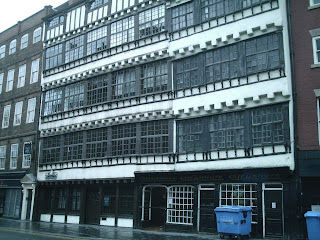 . The last time I visited Newcastle it was raining too. In fact staying in the newly trendy Quayside involves some extremely steep steps (as Newcastle isn't UPon Tyne for nothing) and these steps were turned into a water cascade last time, even though it wasn't as bad as that this time. Newcastle is a mostly stone built georgian city, although J Poulson and T Dan Smith corruptly redeveloped the city in the 1960s giving it the concrete jungle look as shown in Picture 3.
. The last time I visited Newcastle it was raining too. In fact staying in the newly trendy Quayside involves some extremely steep steps (as Newcastle isn't UPon Tyne for nothing) and these steps were turned into a water cascade last time, even though it wasn't as bad as that this time. Newcastle is a mostly stone built georgian city, although J Poulson and T Dan Smith corruptly redeveloped the city in the 1960s giving it the concrete jungle look as shown in Picture 3.
The first picture shows Bessie Surtees's House which is a Jacobean dwelling on the Quayside near the town hall. Bessie Surtees lived here and eloped with John Scott who was to become Lord Chancellor of England and first Earl of Eldon. The second picture shows the bottom of Grey Street, which I regard as an iconic view of Newcastle. Newcastle is picturesque in a sublime way but not particularly photogenic. The view shows the mighty railway bridge at the Scotland end of the Central Station crossing the street at high level. Sublime!
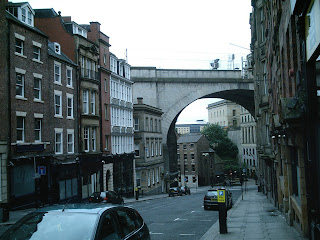 The third picture shows Holy Jesus Hospital, which began life as an alms house - a "Hospital for poor people by the expense of the citizens and leaders of Newcastle upon Tyne in the year of salvation 1683. Built by Timothy Robson, Mayor, John Squire Sheriff. Faith Hope and Charity, and the greatest of these is Charity." The building housed the Central Soup Kitchen, as shown by the plaque in the picture in the 19th Century and a museum (that was always closed) until 1994 when it was transferred to Newcastle Discovery. Now it is used by the National Trust on lease from the Newcastle Council.
The third picture shows Holy Jesus Hospital, which began life as an alms house - a "Hospital for poor people by the expense of the citizens and leaders of Newcastle upon Tyne in the year of salvation 1683. Built by Timothy Robson, Mayor, John Squire Sheriff. Faith Hope and Charity, and the greatest of these is Charity." The building housed the Central Soup Kitchen, as shown by the plaque in the picture in the 19th Century and a museum (that was always closed) until 1994 when it was transferred to Newcastle Discovery. Now it is used by the National Trust on lease from the Newcastle Council.
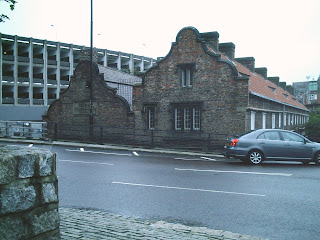
I couldn't get away from Newcastle without a picture of the Tyne Bridge, opened by King George V with Queen Mary in the 1930s, so that's at Picture 4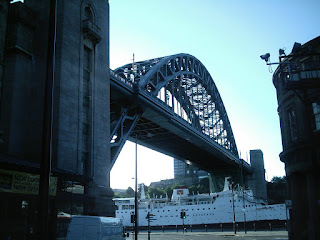 .
.
Newcastle is also a diocese of the modern foundation, a breakaway from Durham in 1882, with the Cathedral of St Nicholas. I thought I might attend evensong there on Sunday night after hearing the church bells ringing at quarter past five. I was hungry and going to eat (see below) but the service was at six and I couldn't wait that long. On the Monday morning I was out at 7:30 (hungry again) and the morning service was at 8:30 so I missed the service again. Frustrated in the Cathedral.
You can see the cathedral tower in the background of this picture of the new castle.
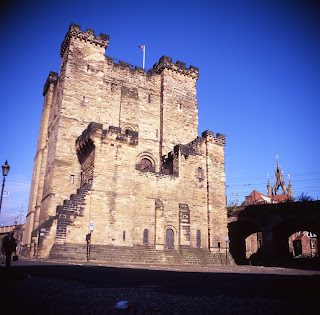
I should always remember that in the provinces people only get hungry between 12 and 3 and not at all on Sunday evenings. When I arrived in Newcastle I wasn't hungry but was at about 5 o'clock. No pub was serving food (or had any left - which is another way of saying the same thing) so had to go to an Indian restaurant, and even there they said the special wasn't available until six. As it was ten minutes to I said "it's nearly six, so that's what I'll have please". I think i was lucky to get it. I have to say that if I did leave London, eating by the clock is the thing that would irritate me intensely.
 . The last time I visited Newcastle it was raining too. In fact staying in the newly trendy Quayside involves some extremely steep steps (as Newcastle isn't UPon Tyne for nothing) and these steps were turned into a water cascade last time, even though it wasn't as bad as that this time. Newcastle is a mostly stone built georgian city, although J Poulson and T Dan Smith corruptly redeveloped the city in the 1960s giving it the concrete jungle look as shown in Picture 3.
. The last time I visited Newcastle it was raining too. In fact staying in the newly trendy Quayside involves some extremely steep steps (as Newcastle isn't UPon Tyne for nothing) and these steps were turned into a water cascade last time, even though it wasn't as bad as that this time. Newcastle is a mostly stone built georgian city, although J Poulson and T Dan Smith corruptly redeveloped the city in the 1960s giving it the concrete jungle look as shown in Picture 3.The first picture shows Bessie Surtees's House which is a Jacobean dwelling on the Quayside near the town hall. Bessie Surtees lived here and eloped with John Scott who was to become Lord Chancellor of England and first Earl of Eldon. The second picture shows the bottom of Grey Street, which I regard as an iconic view of Newcastle. Newcastle is picturesque in a sublime way but not particularly photogenic. The view shows the mighty railway bridge at the Scotland end of the Central Station crossing the street at high level. Sublime!

I couldn't get away from Newcastle without a picture of the Tyne Bridge, opened by King George V with Queen Mary in the 1930s, so that's at Picture 4
 .
. Newcastle is also a diocese of the modern foundation, a breakaway from Durham in 1882, with the Cathedral of St Nicholas. I thought I might attend evensong there on Sunday night after hearing the church bells ringing at quarter past five. I was hungry and going to eat (see below) but the service was at six and I couldn't wait that long. On the Monday morning I was out at 7:30 (hungry again) and the morning service was at 8:30 so I missed the service again. Frustrated in the Cathedral.
You can see the cathedral tower in the background of this picture of the new castle.

I should always remember that in the provinces people only get hungry between 12 and 3 and not at all on Sunday evenings. When I arrived in Newcastle I wasn't hungry but was at about 5 o'clock. No pub was serving food (or had any left - which is another way of saying the same thing) so had to go to an Indian restaurant, and even there they said the special wasn't available until six. As it was ten minutes to I said "it's nearly six, so that's what I'll have please". I think i was lucky to get it. I have to say that if I did leave London, eating by the clock is the thing that would irritate me intensely.
18 August, 2007
Places where they sing: Churches and chapels around Chelsea and Victoria.
What started out as a mosey round the City to take pictures of Unilever House, the Blackfriars pub and the Daily Express building turned suddenly (I don’t know how) into a march round the churches of Chelsea and Pimlico. After taking the pictures I wanted to take I set off (via Kings Cross – where I took some pictures of Levita House) for Sloane Square, with the intention of walking down the Kings Road and back up the embankment and other streets, to Victoria, taking some pictures all the way.
Update - Levita House, named after the then chairman of the LCC housing Committee has now been featured as the Twentieth Century Society's Building of the Month for September. http://www.c20society.org.uk/docs/building/0907_ossulston/oss_text.html. Remember you read it here first...

I saw the Church of Scotland Church of St Columba at the end of Pont Street that was the scene of Sapphire’s wedding in AbFab. I’m not totally ignorant of modern cultural references….
My first port of call was the “Cathedral of the Arts and Crafts Movement” Holy Trinity Sloane Street. A church where the sanctuary was alarmed, but the nave was calm and composed. The church was full of Tractarian chairs and the windows were full of William Morris glass to designs by Sir Edward Burne-Jones, the east window being filled with beautiful portraits of saints in glass, a most striking effect. The other windows were in those very strange arts and crafts colours that seem dull and glowing at the same time. The effect is pleasing. Leaving the church I went past the Peter Jones Department Store, an essay in modernism, and walked down the Kings Road, named thus as it was a means for the King to get from London to Hampton Court in the days when this journey was not nearly so easy as it is today.
I would have called into St Luke’s Church but a wedding was either awaited or departing so I did not go in. I didn’t take a photograph either although it would have looked good with the vested clergyperson in front – a reminder of the proper purpose of a church.
Continuing down the King’s Road I went down to the river via Beaufort Street, having had a glimpse into the grounds of the Moravian Church, a dignified protestant denomination who now inhabit Thomas More’s garden.
Beaufort Street has the original Chelsea Council Flats of 1904, all named after dukes. At the end of the street is Crosby Hall.
Crosby Hall has recently been restored, but was transferred to the Embankment in 1910 after standing since 1446 in Bishopsgate. Previously a club for women graduates, it is rumoured that the Crown was offered to Richard III under its roof. Now it appears to be in private hands again, having, since King Richard’s time been a prison, a meeting house, a warehouse, a concert hall and a restaurant.
Next to Crosby Hall is Chelsea Old Church, which was destroyed by bombing in the second world war but was rebuilt. A fine church that saved its chained library and some of its old glass, and these are now within the building. There are decadent sculptures of naked women on the embankment near the church.
Leaving the embankment and walking past Gordon Ramsey™’s restaurant I came to Christ church. Consecrated in 1839 it was built cheaply for £4000, (St Luke’s, built in 1824, cost £40000) to accommodate the servants who were starting to work in the large houses in Chelsea and Belgravia. The church had its own schools for infants and juniors (no seniors in those days). In the church I noticed some stained glass windows behind the font near the door of the church and some marble panels below. A small but pleasant place to worship although I was reminded of Betjeman’s
‘Oh cheerful substitution
Thou varnished pitch-pine’
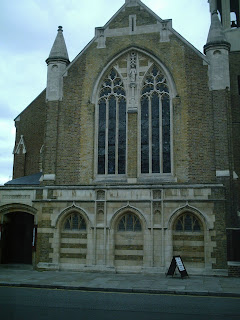
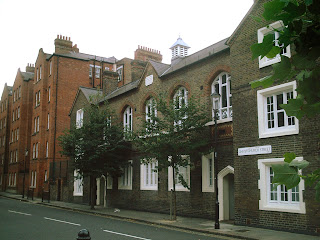
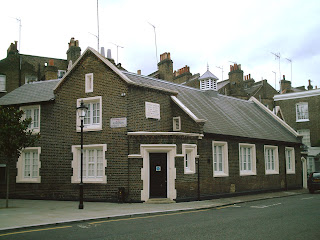
Forward to the Royal Hospital Chelsea, another place where they sing. Founded by King Charles II and built by Sir Christopher Wren as a response to Les Invalides in Paris I always wonder if that king didn’t just carry on plans that had been made by Cromwell. Kings and rulers come and go but the Civil Service (and the military of course) goes on for ever. It doesn’t seem like a King Charles II gesture to me, as he was more interested in harlotry and vindictiveness than the welfare of the Kingdom. Still the Royal Hospital has considerable accommodation for army pensioners, although rather spartan in contrast to the grand surroundings. There is a little pub for them to socialise in and a dining hall linked to a chapel. The chapel had a rather martial scene of the resurrection painted over the holy table and was comfortably furnished. The dining hall was also homely with some pleasant fixtures. Hope the food’s good for the old soldiers.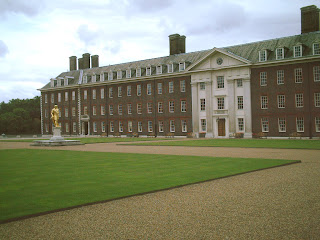
The next church I spotted was St Barnabas Pimlico. A forerunner of the Tractarian movement it sported some high gothic art although built too early for Tractarian chairs in the 1840s. The windows were by Kemp with a wheatsheaf on them (I didn’t like to ask if it was part of the Coöperative – sure it wasn’t). Kemp revived the art of stained glass making and to him we owe the stained glass in our more recent churches. There were some beautiful mosaic panels but the main decoration, as is right in ritualist churches, was for the chancel, a place where they sing. The chancel was a riot of colour and pattern on every possible surface. I can’t really do justice to the exuberance of the decoration, including the reredos (six candlesticks), the organ, the floor with its brasses and everything. A glorious church! Then it was time to go home, at least on a high note.
Update - Levita House, named after the then chairman of the LCC housing Committee has now been featured as the Twentieth Century Society's Building of the Month for September. http://www.c20society.org.uk/docs/building/0907_ossulston/oss_text.html. Remember you read it here first...

I saw the Church of Scotland Church of St Columba at the end of Pont Street that was the scene of Sapphire’s wedding in AbFab. I’m not totally ignorant of modern cultural references….
My first port of call was the “Cathedral of the Arts and Crafts Movement” Holy Trinity Sloane Street. A church where the sanctuary was alarmed, but the nave was calm and composed. The church was full of Tractarian chairs and the windows were full of William Morris glass to designs by Sir Edward Burne-Jones, the east window being filled with beautiful portraits of saints in glass, a most striking effect. The other windows were in those very strange arts and crafts colours that seem dull and glowing at the same time. The effect is pleasing. Leaving the church I went past the Peter Jones Department Store, an essay in modernism, and walked down the Kings Road, named thus as it was a means for the King to get from London to Hampton Court in the days when this journey was not nearly so easy as it is today.
I would have called into St Luke’s Church but a wedding was either awaited or departing so I did not go in. I didn’t take a photograph either although it would have looked good with the vested clergyperson in front – a reminder of the proper purpose of a church.
Continuing down the King’s Road I went down to the river via Beaufort Street, having had a glimpse into the grounds of the Moravian Church, a dignified protestant denomination who now inhabit Thomas More’s garden.
Beaufort Street has the original Chelsea Council Flats of 1904, all named after dukes. At the end of the street is Crosby Hall.
Crosby Hall has recently been restored, but was transferred to the Embankment in 1910 after standing since 1446 in Bishopsgate. Previously a club for women graduates, it is rumoured that the Crown was offered to Richard III under its roof. Now it appears to be in private hands again, having, since King Richard’s time been a prison, a meeting house, a warehouse, a concert hall and a restaurant.
Next to Crosby Hall is Chelsea Old Church, which was destroyed by bombing in the second world war but was rebuilt. A fine church that saved its chained library and some of its old glass, and these are now within the building. There are decadent sculptures of naked women on the embankment near the church.
Leaving the embankment and walking past Gordon Ramsey™’s restaurant I came to Christ church. Consecrated in 1839 it was built cheaply for £4000, (St Luke’s, built in 1824, cost £40000) to accommodate the servants who were starting to work in the large houses in Chelsea and Belgravia. The church had its own schools for infants and juniors (no seniors in those days). In the church I noticed some stained glass windows behind the font near the door of the church and some marble panels below. A small but pleasant place to worship although I was reminded of Betjeman’s
‘Oh cheerful substitution
Thou varnished pitch-pine’



Forward to the Royal Hospital Chelsea, another place where they sing. Founded by King Charles II and built by Sir Christopher Wren as a response to Les Invalides in Paris I always wonder if that king didn’t just carry on plans that had been made by Cromwell. Kings and rulers come and go but the Civil Service (and the military of course) goes on for ever. It doesn’t seem like a King Charles II gesture to me, as he was more interested in harlotry and vindictiveness than the welfare of the Kingdom. Still the Royal Hospital has considerable accommodation for army pensioners, although rather spartan in contrast to the grand surroundings. There is a little pub for them to socialise in and a dining hall linked to a chapel. The chapel had a rather martial scene of the resurrection painted over the holy table and was comfortably furnished. The dining hall was also homely with some pleasant fixtures. Hope the food’s good for the old soldiers.

The next church I spotted was St Barnabas Pimlico. A forerunner of the Tractarian movement it sported some high gothic art although built too early for Tractarian chairs in the 1840s. The windows were by Kemp with a wheatsheaf on them (I didn’t like to ask if it was part of the Coöperative – sure it wasn’t). Kemp revived the art of stained glass making and to him we owe the stained glass in our more recent churches. There were some beautiful mosaic panels but the main decoration, as is right in ritualist churches, was for the chancel, a place where they sing. The chancel was a riot of colour and pattern on every possible surface. I can’t really do justice to the exuberance of the decoration, including the reredos (six candlesticks), the organ, the floor with its brasses and everything. A glorious church! Then it was time to go home, at least on a high note.
09 August, 2007
The British Library and the Horse Hospital
Today is the anniversary of the death of Joe Orton who was bludgeoned to death by his jealous lover 40 years ago.
Jim Hollands, a very talented (in both senses of the word) filmmaker has made a film of the Associated Rediffusion television play of The Erpingham Camp. I went after seeing an exhibition on the similarities between Christians Jews and muslims at the British Library. I especially liked seeing King David depicted as Henry VIII.
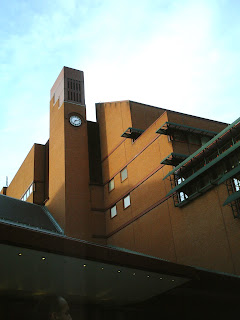
Jim Hollands, a very talented (in both senses of the word) filmmaker has made a film of the Associated Rediffusion television play of The Erpingham Camp. I went after seeing an exhibition on the similarities between Christians Jews and muslims at the British Library. I especially liked seeing King David depicted as Henry VIII.

08 August, 2007
Kew Gardens
A pleasant day spent in Kew Gardens with colleagues as an away day from work. The weather was beautiful as we sat on the train for half an hour outside Gunnersbury due to a buckled rail. Anyway we got to Kew and the first thing I saw was a horse and carriage driven by a good looking bloke in Jodphurs and hunting boots. Why he was wearing these when he wasn't sitting on the horse I don't know, but they looked good on him so I suppose...
After a picnic and team building exercise it was time to walk down to the Palm House and have a look in there.
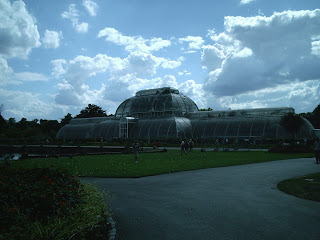
The Palm House contained some very big palms and a beautiful marine display. It was fronted by stone efigies of the kings beasts. After the palm house I had a look round the lake which was most enjoyable.
After a picnic and team building exercise it was time to walk down to the Palm House and have a look in there.

The Palm House contained some very big palms and a beautiful marine display. It was fronted by stone efigies of the kings beasts. After the palm house I had a look round the lake which was most enjoyable.
04 August, 2007
Brighton Pride
A brief visit to work on the Coöperative membership stall at Brighton Pride. This is the third year I've done it and this year I was wearing a large heart (front and back) and giving out postcards Some readers may have seen me there. I also went down to the sea front with Mark. The journey (on the hottest weekend so far this year) was a predictable nightmare.
Haven't got a pic this time so here's a historical one when the west pier wasn't a piece of charred ironwork.
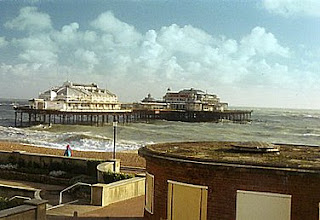
Haven't got a pic this time so here's a historical one when the west pier wasn't a piece of charred ironwork.

Subscribe to:
Posts (Atom)

